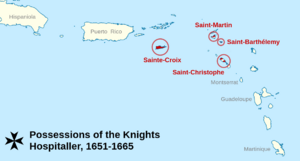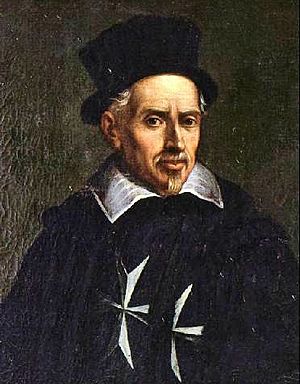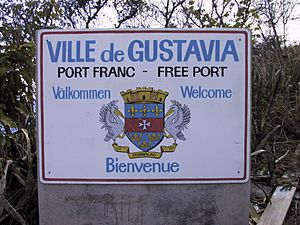Hospitaller colonization of the Americas facts for kids
The Hospitaller colonization of the Americas was a time when the Knights Hospitaller of Malta owned four Caribbean islands. This happened for 14 years in the 1600s. The islands were Saint Christopher, Saint Martin, Saint Barthélemy, and Saint Croix. At this time, Malta was a small state connected to the Kingdom of Sicily. The Knights were led by an Italian leader named Grand Master Giovanni Paolo Lascaris.
The Knights were involved in the Caribbean because they had strong ties with the French nobility. Many Knights were also French leaders in the Americas. A key person in this short period of colonization was Phillippe de Longvilliers de Poincy. He was both a Knight of Malta and the governor of the French colonies in the Caribbean. Poincy convinced the Knights to buy the islands in 1651. They bought them from a French company that was going broke, called the Compagnie des Îles de l'Amérique. Poincy stayed to govern the islands until he died in 1660. During this time, the Knights owned the islands. However, the King of France still had official power over them. Poincy mostly ruled the islands on his own. In 1665, the Knights sold their rights to the islands. They sold them to a new group called the French West India Company. This ended their time as colonizers.
Contents
Why the Knights Went to the Americas
From the very start of French colonization of the Americas, members of the Knights of Malta were important figures. They were active in New France (which is now Canada) and the French Caribbean. Most of the Knights were French nobles. Many French navy officers also trained with the Knights' navy.
Many Knights held high positions in the early French colonies. These included Aymar Chaste and Isaac de Razilly in Acadia. Charles de Montmagny was also a Knight in Quebec. In 1635, Razilly suggested that the Knights set up a base in Acadia. But the Grand Master, Fra' Antoine de Paule, said no to the idea.
The next Grand Master, Giovanni Paolo Lascaris, was more interested in colonies. In 1642 or 1643, he became the godfather to an Abenaki person who converted to Christianity in New France. Montmagny stood in for Lascaris at the baptism ceremony.
Phillippe de Longvilliers de Poincy was the founder of the Knights' colonies. He started his career like other leaders. Longvilliers fought against the Turks in the Mediterranean Sea. He also took part in the Sieges of the Isle of Ré and La Rochelle in 1627. In between these events, he worked under Razilly in Acadia, where he commanded a fort.
The Knights' Time in the Caribbean
Poincy first arrived on Saint Christopher in 1639. He was the appointed governor under the Compagnie des Îles de l'Amérique. Soon after, King Louis XIII made Poincy his Lieutenant-General for the whole Caribbean. Poincy started spending a lot of money on building projects on the island.
He also expanded French control to other islands. He started the first European settlement on Saint-Barthélemy in 1648. He also founded a settlement on St. Croix in 1650-51. He sent 300 more men to help and take over the small French settlement on Saint-Martin. There, he made the Treaty of Concordia. This treaty set the border between the French and Dutch settlements, which is still there today.
Poincy also became the absolute ruler of the islands. He often ignored the failing French company's authority. He got into arguments with the Capuchin missionaries. They did not like that the governor spent time with local English, Dutch, and Huguenot Protestants. They also disliked his refusal to free the children of baptized slaves. Poincy also made people angry with his harsh treatment of those who went against him. He also upset the Order of Malta by using money from their estates in Europe. He used this money to pay for his fancy lifestyle on the island.
The company's leaders decided to replace Poincy. They chose Noëlle Patrocles de Thoisy to take his place. The king even ordered Poincy to return to France. But Poincy refused to obey. His soldiers forced Thoisy off the island. Thoisy was eventually captured and sent back to France in chains.
To keep his job, Poincy suggested in 1649 that the Order of Malta buy the islands. By this time, the French company was struggling. Poincy himself had shown how weak it was by ignoring its rules. Also, Cardinal Mazarin, France's chief minister, was busy with the Peace of Westphalia. He could not focus on colonization. In 1651, the company was closed down. Its rights to use the islands were sold to different groups. Martinique, Guadeloupe, and other islands were sold to private people.
The Knights Hospitaller, with Grand Master Lascaris's approval, bought Saint-Christophe. They also bought Poincy's new settlements of Saint Croix, Saint Barthélemy, and Saint Martin. The Knights' representative in France, Jacques de Souvré, signed the deal. The Knights' ownership rights were confirmed in a treaty with France two years later. The king would remain the ruler, but the Knights would have full control over the islands. The only rules were that they could only send French knights to govern. Also, for each new King of France, they had to give a gold crown worth 1,000 écus.
The Grand Master's council decided that Poincy could stay as governor. But they also sent the former governor of New France, Charles de Montmagny. He was named "proconsul general" to look after their interests on Saint Christopher. Montmagny hoped to help Poincy fix the colonies' money problems. However, Poincy again did not want any outside help. After Montmagny went back to France, Poincy sent away the person left in his place. The Order sent Montmagny a second time in 1653 as "lieutenant governor." He officially took control of the islands for the Grand Master. But Poincy still refused to share power. Montmagny was quickly pushed aside. He spent his time on a farm on Saint Christopher, hoping to take over after Poincy died. Montmagny died first, in 1657.
Poincy continued to develop the colonies. He built strong forts on Saint Christopher. He also built churches, roads, a hospital, and his own large home, the Château de la Montagne. Outside the main capital, the Knights' rule was less stable. The settlement on Saint Barthélemy was attacked by Carib people. Those who were not killed left the island. Poincy sent 30 men to replace them, and this group grew to 100 by 1664. In 1657, a rebellion overthrew the Knights' rule on St. Croix. Poincy sent a new governor to restore order. This governor built forts and a monastery. He also started clearing much of the island's forests for farming.
To replace Montmagny, the Order sent two new lieutenant governors. The more important one was Charles de Sales. He was a relative of St. Francis de Sales and was liked by the island's people. Shortly before he died in 1660, Poincy signed a peace treaty with the English and the Carib people of Saint Christopher. But the peace did not last. De Sales became governor after Poincy. In 1666, after the Knights had officially given up control of the islands, fighting broke out between the French and the English. In a battle at Cayonne, de Sales was killed. But the French managed to keep their settlements.
By the early 1660s, people were frustrated that the colonies were not making money. The Order still owed France money for buying the islands. In Malta, the Knights discussed whether they should sell them back. Jean-Baptiste Colbert, who was much more interested in colonies than Mazarin, was now powerful in King Louis XIV's court. He pressured the Knights to sell. In 1665, the Knights sold their colony to the new Compagnie des Indes occidentales.
Governors on Saint Christopher
- Phillippe de Longvilliers de Poincy, 1651–1660 (He was governor under the French company from 1639)
- Charles de Sales, 1660–1666
- Claude de Roux de Saint-Laurent (1666–1689)
What Was Left Behind
The Knights of Malta never started another colony. However, members of the Order stayed active in France's navy and its overseas empire. Several Knights were involved in the Mississippi Company plan in the early 1700s. Later in that century, Étienne-François Turgot, a Knight and colonial leader, tried to settle Maltese people in Guiana. But he was not successful.
The short time the Knights were in charge is still remembered on the different islands. Poincy's rule on St. Kitts is remembered for his grand household. His servants all wore the emblem of the Knights. On St. Croix, people often talk about the "seven flags" in the island's history. This includes the Knights of Malta, along with the United States and five European nations that have ruled it. Saint Barthélemy has a Maltese cross on its coat of arms. This red cross represents the time of Hospitaller colonization.
See also
 In Spanish: Colonización hospitalaria de América para niños
In Spanish: Colonización hospitalaria de América para niños
- Italy and the colonization of the Americas





